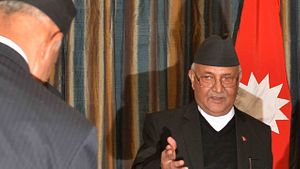If the winner in the recent Nepal elections, the Left alliance, wanted to send out a message that it would follow a “balanced” foreign policy, then surely its leader Khadga Prasad (KP) Sharma Oli, has a strange way of demonstrating this. In a surprise move, Oli visited the border with China in Rasuwagadhi last week and declared that the Rasuwagadhi-Kerung border point, the only trade and transit point between Nepal and China, would be upgraded to international standards. This came days before he blamed sections of the Indian media for creating rift between the Left coalition and New Delhi.
The Indian Ministry of External Affairs, for its part, had welcomed the outcome of Nepali elections. In its official statement, it said:
We congratulate the government and the people of Nepal. India has age old unique, time tested ties of friendship with the country. We look forward to working with the next democratically elected government in Nepal to advance our close and multifaceted partnership across all sectors and to support Nepal in its pursuit of peace, stability, economic prosperity and all round development.
But clearly a new phase has begun in India-Nepal relations with the decisive victory of the coalition of the Communist Party of Nepal (Maoist Centre) led by Pushpa Kamal Dahal (Prachanda) and the Communist Party of Nepal (Unified Marxist Leninist), led by Oli. The Nepali Congress has been routed. The Nepali Congress claims that elections for the Upper House need to be completed before a new government can be formed. The scale of victory for the Left coalition can be expected to bring some stability to a country that has faced continuous political turmoil for the past two decades. After the Maoist insurgency ended, several prime ministers have come and gone, unable to manage a political transition in the erstwhile Himalayan Kingdom effectively. The constitution-making process has been equally tortuous, with the eventual promulgation of a new document in 2015 leading to the mobilization of the Madhesi groups in the Terai region against what they perceived to be a discriminatory document.
The blockade along the Nepal-India border in September 2015 by Madhesi groups was blamed on India and it was then that Oli emerged as a vocal critic of New Delhi’s policy towards Nepal, even as he made his intention of taking his country closer to China clear. Oli secured China’s support during the six-month long blockade and after he was forced to resign, he had accused India of effecting a government change by forcing Maoists to withdraw support from his government through a “remote control.” Oli made it an electoral issue by raising the India bogey during his campaign, scapegoating New Delhi for the blockade and for breaking the coalition.
The blockade along the India-Nepal border due to the Madhesi crisis indeed had angered a large part of the Nepalese population, allowing China to step in as an alternative to India by providing not only internet access, but also alternative trade routes. Nepal’s economy has been ailing since the earthquake of 2015 as its reliance on aid and remittances remains at an all time high. China’s attraction under such circumstances is quite natural. Beijing has pledged $8.3 billion to build roads and hydropower plants in Nepal even as Indian commitments remain in the realm of $317 million. As part of its ambitious “One Belt, One Road” initiative, Beijing is looking into the possibility of connecting Kathmandu to Lhasa in Tibet via railways at an estimated cost of $8 billion. China’s activities have been steadily expanding in Nepal after Kathmandu’s support for OBOR materialized. This happened despite India’s stiff resistance to OBOR.
The Modi government’s proactive outreach to Nepal in its early days suffered a setback due to the Madhesi crisis. The Deuba government had decided to cancel a major $2.5 billion hydroelectric project awarded to Chinese state company China Gezhouba Group in November 2017 much to the annoyance of Beijing. The new government in Nepal will reverse the decision. Oli had warned against revoking the plan.“The issue here is about foreign investment and such decisions cannot be taken on a whim,” he had said. Chinese President Xi Jinping is likely to visit Nepal in March 2018. He was supposed to visit last year, but the trip had to be cancelled it due to a change of government in Nepal. China’s major security interests in Nepal include its border with the Tibet autonomous region, a potential hotbed of domestic instability over questions of sovereignty.
While New Delhi will be viewing the developments in Nepal with some concern, for Kathmandu there is a greater room for maneuverability now between China and India. India cannot and should not prevent Nepal from developing closer links with China so long as Kathmandu remains cognizant of vital Indian interests. Nepali leaders also recognize that the links with India, which traverse history, culture, and geography, cannot be severed so easily. And while Oli may look like a difficult proposition for India, New Delhi should also be aware that all governments in Nepal have tried to play the China card vis-à-vis India. Oli will not be unique in that respect nor will he be the last.

































